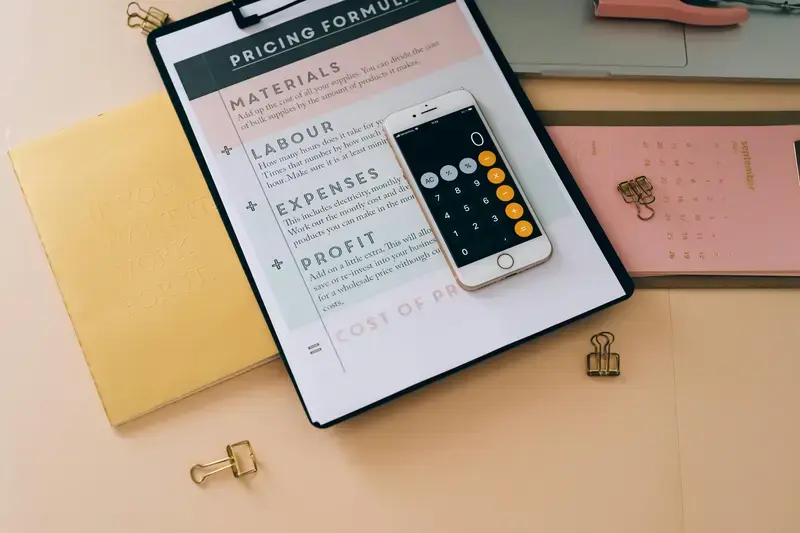Is It Expensive to Build an App?
At Glance, one of the most common questions we get asked is whether building an app is expensive? The short answer is, it can be. But don't panic just yet! The long answer is a bit more nuanced and, thankfully, within your control.
You've probably heard stories of start-ups splashing hundreds of thousands of pounds on a single app, only to recoup their costs with interest. On the other hand, you might know someone who bootstrapped their way through developing a simple app for a fraction of that price. So where does the cost of apps really sit?! The truth lies somewhere in between and understanding what influences these costs can help you make a more informed decision.
Anything that is valuable will surely cost you something, either time or money. It's about knowing what you're willing to invest and what you can reasonably expect to get back.Sarah, Business Analyst
Before we dive into development costs, I want to take a moment to say we I understand what you're feeling right now. You're juggling budgets, deadlines, and expectations from stakeholders. You're probably thinking, "What exactly am I going to walk away with?" Well, here's a promise: by the end of this guide, you'll have a clearer picture of the costs involved, what factors influence those costs, and how you can manage your budget effectively.
Breaking Down Development Costs
So how much will it actually cost to build your app? Well, this can vary quite a bit depending on a few key elements. These include the complexity of your app, the number of features you want, the design, the end goal and the team's experience level. To give you a clearer picture, we've broken it down into a few stages with approximate percentages of your total budget.
1. Project Analytics Phase (15% of development costs)
This is where it all starts—think of it like drawing up blueprints for a house. During this phase, we outline your app's goals, key features, and build your roadmap. Every penny spent here is crucial, as it sets the tone for the entire project.
2. UX/UI Design Phase (20% of budget)
The look and feel of your app are incredibly important because users are quick to judge based on appearance, not just function. This phase covers everything from user flows to wireframes and final designs. It's all about ensuring your app is user-friendly and visually appealing.
3.App Architecture andDevelopment Phase (55-60% of project)
Here's where the actual building happens. Coding, debugging, and integrating features all fall under this phase. Depending on the number of platforms (like iOS, Android) and the complexity of your app, this stage can be the most time-consuming and costly.
4. App Launch Phase (5-10% of development costs)
Finally, getting your app into users' hands involves some costs too. This includes submitting your app to app stores and initial marketing efforts to get noticed. It’s essential to ensure everything runs smoothly at launch.
Breaking down these phases helps you see where your money goes and why each stage is essential. Next we'll dive into what factors drive these costs even further.
What Factors Influence App Development Costs?
Let's talk about what really drives the costs behind app development. Understanding these factors can help you manage your budget and set realistic expectations.
1. The Type of App
The nature of your app greatly influences the price. Are you building a native app specifically for iOS or Android, a hybrid app that works across platforms, or a web app? Each type has its own development complexities and maintenance needs. Native apps generally deliver the best performance but come with higher costs as they require a separate codebase for each platform.
2. Complexity and Features
A basic app that performs simple functions will naturally be cheaper than an app with complex features. Think about the features you want – user logins, notifications, payment gateways, GPS integration. Each added function requires more development time and resources, thus increasing the cost.
3. Design and User Experience
Never underestimate the impact of a well-designed app. Good design isn’t just about looks; it’s about making the user experience as seamless as possible. An intricate design with custom visuals, animations, and interactive elements will require more hours of work and an experienced designer, which influences the cost.
4. Third-Party Integrations
If your app needs to integrate with other services – like social media platforms, payment gateways, or other apps – this will also add to the development time and cost. Each integration comes with its own set of complications and requirements that need to be managed carefully.
5. Advanced Technologies
Do you wish to incorporate cutting-edge technologies like Artificial Intelligence (AI), Augmented Reality (AR), or Internet of Things (IoT)? While these make your app stand out, they also significantly drive up development costs due to their complexity and the specialised knowledge needed to implement them.
6. Platform and Device Compatibility
Will your app be developed for multiple platforms like iOS, Android, and maybe even wearable devices? Developing for multiple platforms requires additional effort and testing, which again increases costs. Additionally, ensuring your app works seamlessly on various devices and screen sizes adds to the workload.
Understanding these factors is key to navigating the cost landscape of mobile app development but don't worry; we're here to guide you!
The Hidden Costs to Consider
Alright, let's talk about the costs you don't see coming. Developing an app involves a lot more than just getting the code to work—there are several hidden costs you need to account for to get a complete picture of your investment.
1. Ongoing Maintenance: Think of your app as a living, breathing entity, once the app is live, the job isn't over. Regular updates, bug fixes, and improvements are necessary to keep it running smoothly which can eat up around 20% of your initial development costs each year. Ignoring this might turn your shiny new app into a relic.
2. Testing and Quality Assurance: You wouldn't serve a dish without tasting it first, right? Similarly, extensive testing is crucial to ensure your app works flawlessly across different devices and platforms. This involves both manual and automated testing processes, which can add to the initial cost but are essential for delivering a quality product.
3. App Store Fees: Getting your app onto the Apple App Store or Google Play isn't free. Apple charges a yearly fee of around £79, and Google has a one-time registration fee of about £20. These fees are small but necessary investments to make your app available to the masses.
4. Infrastructure Costs: Your app will need to store and manage data. This requires backend services and cloud storage solutions. Services like Amazon Web Services (AWS) or Google Cloud can help but come with their own set of costs. Depending on your app’s usage, these can fluctuate and need to be budgeted for.
5. Security and Compliance: Keeping user data secure is not just ethical; it’s a legal obligation. Implementing robust security measures and ensuring compliance with data protection regulations like GDPR can incur additional costs. But a security breach could cost you far more, both financially and in terms of reputation.
So there you have it, the sneaky expenses that often get overlooked. By accounting for these from the get-go, you can avoid any nasty surprises down the line and ensure your app is a sustainable success.
Managing Your App Budget Effectively
When it comes to managing your app budget, you’re like the captain of a ship. And like any good captain, you need a detailed map to navigate treacherous waters. Here are some essential tips to keep you on course:
Prioritise Features Wisely
It’s easy to get carried away with bells and whistles, but ask yourself: what features do your users really need? Focus on what adds value, not just what looks flashy. This approach not only keeps your budget in check but also enhances user satisfaction.
Invest in Efficient Project Management
Good project management is like having an experienced first mate. It keeps everything organised and ensures that your app development stays on schedule and within budget. Tools like Jira or Asana can be lifesavers here, helping to keep everyone on track and aligned.
Consider Phased Development
Instead of trying to launch with every feature under the sun, consider phased development. Start with a Minimum Viable Product (MVP) to test the waters. Once you’ve got a feel for what works and what doesn’t, you can invest in more advanced features.
Outsource Strategically
While outsourcing can sometimes feel like walking the plank, it doesn’t have to be. Many tasks, like quality assurance or specific coding elements, can be outsourced to skilled freelancers or firms. This can drastically cut costs, provided you choose reputable and reliable partners.
Regular Communication
Think of your app project like a plant—it needs regular attention! Maintain steady and open communication with your development team. Weekly or bi-weekly updates can prevent misunderstandings and keep everyone aligned, saving you both time and money.
Plan for Maintenance
Don’t forget, launching your app is just the beginning. Like a car, your app will need regular upkeep. Allocate a portion of your budget for ongoing maintenance and updates. This helps you fix bugs, improve functionality, and keep users engaged over the long haul.
Why an App Might Be Worth the Investment
Now, we know what you might be thinking: "This sounds pricey. Is it really worth it?" Let's break it down for you. An app can be a game-changer for your business, and here's why.
First off, think about the reach. An app puts your business right in the pockets of your customers, literally. It's like having a direct line to them. You can send them notifications, updates, and offers at the touch of a button. Imagine the engagement and customer loyalty this could generate.
Secondly, the data. Apps can provide invaluable insights into your customers' behaviours and preferences. With this data, you can tailor your services, improve user experience, and make more informed business decisions. It's almost like having a crystal ball for your business strategies.
The biggest risk is not taking any risk... In a world that is changing really quickly, the only strategy that is guaranteed to fail is not taking risks.Mark Zuckerberg
Let's talk efficiency. An app can streamline numerous processes. Whether it's scheduling, payments, or customer support, apps can make these tasks quicker and more efficient. This means saving both time and money in the long run.
And then there's the brand image. Having a sleek, functional app can give your business a modern and professional edge. It shows users that you're serious about innovation and convenience, which can set you apart from competitors.
Finally, there's the potential for revenue. Depending on your monetisation strategy, your app could become a significant revenue stream. Think in-app purchases, subscription models, and ad revenue. A well-designed app tends to pay for itself over time.
In a nutshell, while developing an app involves upfront costs, the potential return on investment can be substantial. It's about enhancing customer engagement, gaining valuable insights, improving efficiency, boosting your brand, and potentially, creating a new revenue channel. When done right, the benefits of having an app can far outweigh the initial expenses.
Conclusion
So, is it expensive to build an app? Well, as with most things in life, it depends. There are many factors to consider, but it’s not a one-size-fits-all scenario. The cost is influenced by the type of app you want, the complexity of features, the design, and the technologies involved. And let's not forget those sneaky hidden costs that can add up if you’re not careful. But don’t let that scare you off.
By managing your budget wisely, prioritising features, and investing in good project management, you can make your app project a success without breaking the bank. Strategic outsourcing and phased development can keep costs down while ensuring quality and functionality.
An app can be a significant investment, but with careful planning and the right team, it’s one that can pay off, boosting your business and opening up new opportunities. As experts in the field, we're passionate about helping you navigate this journey smoothly yet effectively. Remember, cost-effective doesn’t mean cheap; it means getting the best value for your investment.
The price tag on app development can vary widely based on your specific needs and choices, but with the right approach, you can build an app that’s both cost-efficient and perfectly tailored to your business goals. If you’re ready to explore this exciting venture, let's have a chat and see how we can make it work for you. The app world is waiting, and it might just be the best investment you ever make.
Share this
Subscribe To Our Learning Centre
You May Also Like
These Related Guides

Do I Need Insurance For My Mobile App?

How Much Does It Cost For App Development?



